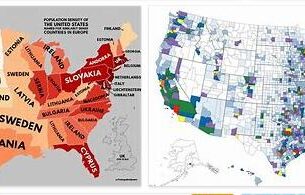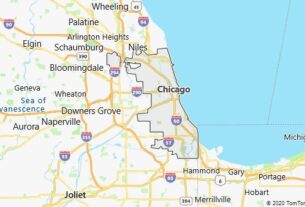Kentucky is a state in the eastern United States. Despite its location, it is still counted among the southern states. Kentucky is one of the four US states known as the Commonwealth, the others being Virginia, Pennsylvania and Massachusetts. Originally, Kentucky was a part of Virginia until 1792, when Kentucky became the 15th state to join the Union.
With an area of approximately 104,659 km², Kentucky is the 37th most extensive and the 26th most populous of the 50 United States. Frankfort is Kentucky’s capital, but its largest city is Louisville.
Kentucky borders seven states: West Virginia to the east, Virginia to the southeast, Tennessee to the south, Missouri to the west, Illinois and Indiana to the northwest, and Ohio to the northeast.
” Bluegrass State ” is the state’s nickname, based on the bluegrass that grows in many of the pastures here. The region is also known for being home to the highest number of deer and turkeys per capita in the United States. It is also home to the largest free-roaming herd of moose east of the Mississippi River. Kentucky is also known for horse racing, bourbon distilleries like Jim Beam, automobile manufacturing, tobacco, bluegrass, college basketball and Kentucky Fried Chicken.
US President Abraham Lincoln, Jefferson Davis as President of the Confederacy, actor George Clooney, Johnny Depp and Tom Cruise are from Kentucky.
Climate in Kentucky
Kentucky has a climate that is referred to as a humid subtropical climate. Summer temperatures hover around 87°F (31°C) and winters can get as cold as 23°F (-5°C). Average rainfall is 46 inches (1,200 mm) per year.
In addition, Kentucky lies in the transit area of various storm systems, some of which occur as tornadoes between March and September.
Attractions in Kentucky
The world’s longest cave system, Mammoth Cave National Park is a popular Kentucky attraction. In the metropolises like Louisville and Lexington you will find many classic sights.
UNESCO World Heritage Sites
Mammoth Cave National Park is located in central Kentucky.
National Parks in Kentucky
Mammoth Cave National Park
Cities and larger towns in Kentucky
Lexington
Frankfort
Louisville
Bowling Green
Owensboro
Covington
Hopkinsville
Universities in Kentucky
University of Kentucky at Lexington
Transylvania University at Lexington
Kentucky State University at Frankfort
University of Louisville
Airports in Kentucky
Louisville International Airport (Standiford Field (SDF)) from Louisville
Cincinnati/Northern Kentucky International Airport (CVG)
Blue Grass Airport (LEX) in Lexington.
Rivers & Lakes in Kentucky
Mississippi
Ohio River
Cumberland River
Tennessee River
Kentucky River
Big Sandy River
Lake Cumberland
Kentucky Lake
Lake Barkley
Mountains in Kentucky
Appalachian Mountains
Cumberland Mountains
Black Mountain
Big Bone Lick State Park near the Ohio River
Big Bone Lick State Park is located in Big Bone in Boone County, Kentucky. During the Pleistocene of the last Ice Age there were many herds of animals roaming this region. They were probably drawn to the salty spots where you could pick up minerals to supplement your diet.
Centuries later, fossils of animals that have traveled here have still been found. Particularly rare large bones from the mammoth gave the area the name Big Bone. In addition, fossils of ancestors of sloths, bison and horses have been found here.
At that time, the area around the springs was very swampy, which made it difficult for many animals to get out of the swamp or got stuck and died. The area is also known as the cradle of American paleontology due to the many fossils that have been found here.
Meanwhile, this Kentucky state park has become very popular with its 2,000 acres which has a 100 acre picnic area and campground with electricity, water, grills, a bathhouse and a pool. Every visitor gets their money’s worth here, there are facilities for various leisure activities. In the park you will find a modern museum and visitor center with paleontological and archaeological exhibits. Life-size replicas of mammoths, mastodon, sloths and bison can be found in the adjacent area.
History of Big Bone Lick State Park
First Indians populated the area. It was not until 1739 that the European Charles LeMoyne found the first elephant bones. Shortly thereafter, Robert Smith, an Indian trader, visited the area and took many fossils with him. According to McAfee later discovered the region, he found there were dozens of animal hooves at a depth of three to four feet.
Its designation “the cradle of American paleontology” comes from 1807 when an expedition by William Clark under President Thomas Jefferson was conducted here. Many fossils were found in Big Bone Park. The area contributed much to learn more about life before the learn about the last ice age.
When salt was found in this region, a successful salt manufacturing operation began at Big Bone Lick. Its proximity to the Ohio River made it ideal for the salt trade. 500-600 liters of salt water were taken from the salt springs. The water was boiled down until only the salt remained. But when more salt deposits were discovered in the Ohio Valley in 1812, the salt industry in Big Bone Lick came to an end.
In 1953, the Big Bone Lick Association raised money and attempted to create a national park out of the area. The association wanted to build a museum to display some of the objects in Big Bone Lick. Many donations were collected for the project. On July 2, 1960, the country’s Parks Board took over the area and made it a state park. Between 1960 and 1968 the state bought additional land. A lake was built as a water supply. The area continued to expand.
In 2002, Big Bone Lick State Park became an official Lewis and Clark Heritage Site. The park was listed on the National Register of Historic Places in 1972 and added as a National Natural Landmark in February 2009.
Activities at Big Bone State Park
Since 2004, Big Bone Lick Park has had a visitor center with indoor and outdoor fossil exhibits. American art and a 1,000-pound mammoth skull are also on display here. Information material and souvenirs can be bought in the souvenir shop.
The park has several hiking trails, including a Discovery Trail, which follows a boardwalk around a swamp area where mammoth skeletons can be seen. It takes you through different habitats wetlands and savannas. The path has been designed to be handicapped accessible.
Other activities available at this Kentucky state park include bird watching, fishing, miniature golf, campground swimming, picnicking and tennis. Two playgrounds are available for children.
The only larger living animals in the park are a herd of bison.
Big Bone Lick Museum
The Big Bone Lick Museum features exhibits that tell of the park’s significant historical and prehistoric past. Fossils, Ice Age mammal bones and Native American artifacts are on display. The museum is open daily from 8:30am to 4am from April 1st to October 31st and from 9am to 3pm Monday – Friday from November 1st to March 31st.
We are currently working with the Cincinnati Museum Center in Ohio to be able to exhibit more exhibits.
Campground in Big Bone Park
The park has picnic facilities and a campground with over 62 pitches. It has electricity, barbecues, a swimming pool and a playground. Showers, toilets and washing facilities. The campsite is closed from November 1st to March 31st.
Directions to Big Bone Park in Kentucky
Accessible via Beaver Road, Big Bone Lick Park is located between the communities of Beaverlick and Rabbit Hash.
The park is located 22 miles southwest of Covington KY on 338, just off US 42/127 and I-71 & I-75. From I-75 north or south, take exit 175 to KY 338. From I-71 north or south, take exit 62 to 127N/42E KY 338.
Address of the Big Bone Lick State Historic Site in Kentucky
Big Bone Lick State Historic Site
3380 Beaver Road
Union, KY 41091
//parks.ky.gov/parks/historicsites/big-bone-lick/default.aspx



